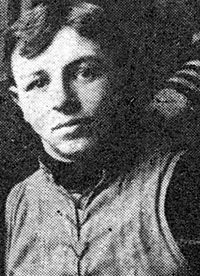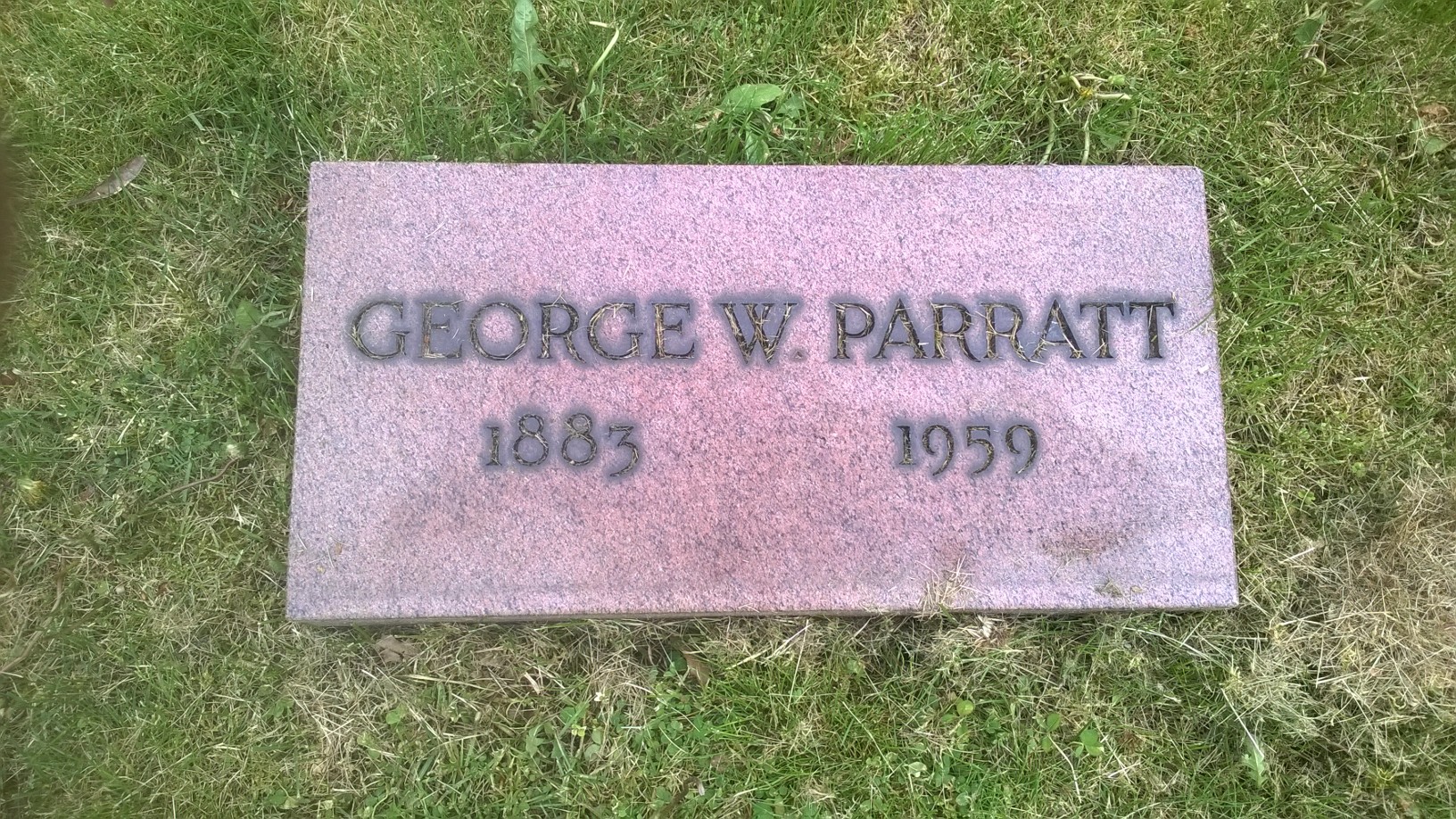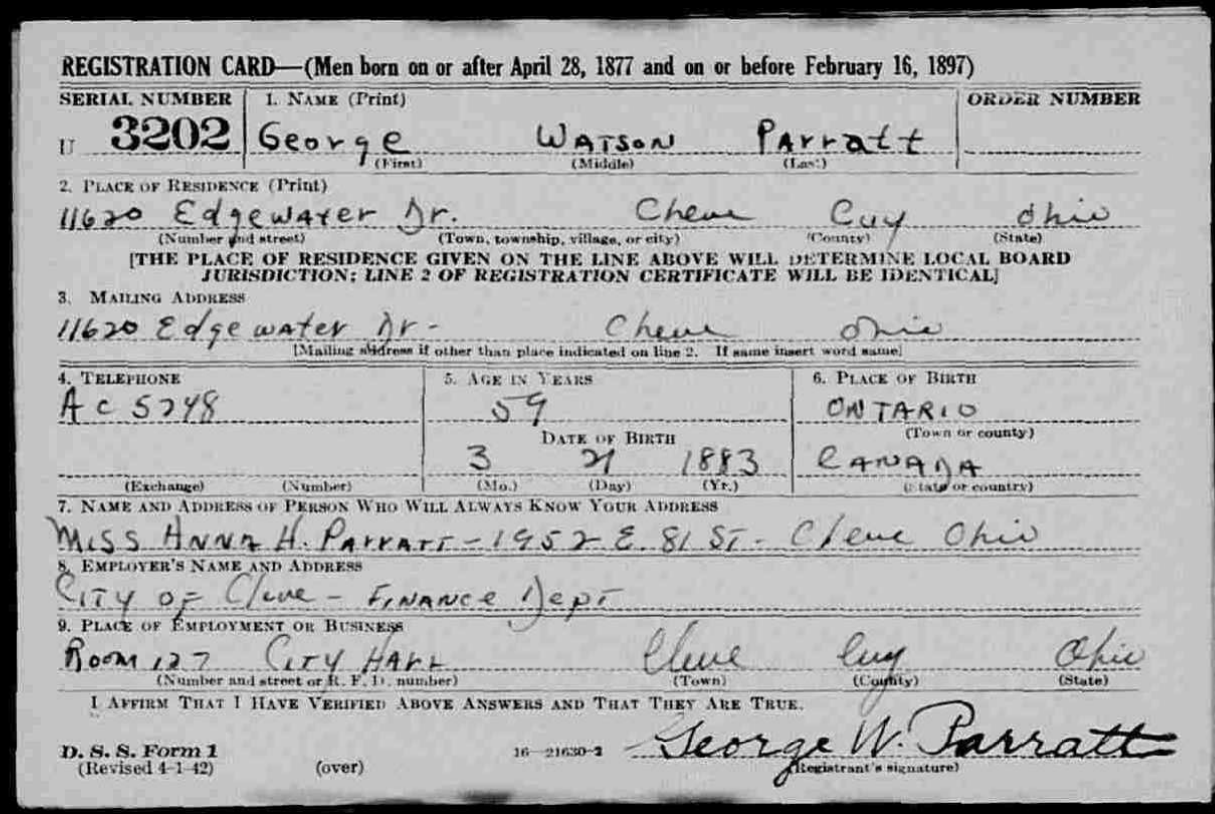Parratt had his college career at Case Western University, where he was a three-time All-Ohio star. In 1905, he put his amateur status on the line and played pro football on Sundays for the Shelby Blues team. He tried to hide his identity by playing under the name "Jimmy Murphy" and covering his face with a nose guard. The Cleveland news soon uncovered that "Murphy" was actually "Peggy" Parratt. Parratt was summoned by the Case University Athletic Board for questioning. He did admit to breaking the amateur code. Case Western barred Parratt from any intercollegiate game, which included basketball and baseball.
Parratt was the first college football star to be penalized for playing with pro status. Other college football players had played professionally but had refuted the charges. Strangely, George was still given his varsity letter because of his leadership. He was even given All-Ohio Honors for 1905 and was permitted to coach the baseball team. Parratt graduated from Case in 1906 and was offered Marietta's head football coach job. He opted against that to play pro football.
Parratt played for the Lorain Pros to finish out the 1905 season. Because of his experience with the forward pass, he was signed by the Massillon Tigers in 1906 and became the first-string quarterback. He may have thrown pro football's first forward pass on October 25, 1906 to Dan "Bullet" Riley in a win over Benwood-Moundsville team, per the book Pigskin: The Early Years of Pro Football by Robert W. Peterson. In the book Pro Football: Its Ups And Downs by Harry March, Eddie Wood of the Canton Bulldogs and Latrobe Athletic Association was mistakenly recognized as catching the first forward pass in pro football in game two of the 1906 Ohio League Championship on November 24, 1906, per Harry March in his book Pro Football: Its Ups and Downs. Further research found that Parratt tossed an earlier pass to Bullet Riley on October 25.
In the Tigers last games against the Canton Bulldogs to decide the kings of the Ohio League, Parratt made two interceptions as his Tigers won the second, and final, game. Unfortunately, fans would avoid pro football in Ohio for a while as whispers of a betting fix circulated. As the news made its rounds, several of the best players made their way out of Ohio. Football was forced to try to assemble a clean 1907 season using the local sandlot players. Since Parratt didn't participate in the scandal, he continued with the renamed "Massillon All-Stars" to start 1907. George found that the Franklin Athletic Club would pay him more money, so he played some for them, and sometimes refereed Cleveland-area pro football games.
Parratt came back to the Shelby Blues for 1908, as owner, player-coach, and recruiter. That year the Blues beat every opponent, and ended deadlocked with the Akron Indians for top team in Ohio. The next year, the Blues would lose the title to the Indians 13-9. Parratt was also an assistant football coach for Case in 1909.
George's plan for 1910 was to do extensive recruiting. With the better veteran players, he inked highly-touted Ohio college grads. The formula went as hoped, as Shelby beat the favored Akron Indians by 16-6 and later by 8-5. The Ohio title belonged to his Shelby team.
George had success with a similar idea for the 1911 season as Shelby beat Akron by 6-0 and later by 3-0. The 1911 championship game would be contested between the Blues and the Canton Professionals. There was a controversial judgment on an offsides call. Parratt agreed to a compromise, but Canton captain removed his team from the field and even threatened to give up football after the game, as his forfeit awarded the game to Shelby. Turner's desire to defeat Parratt kept him for the next three years with Canton.
George learned that he could earn more money in the bigger Akron market, and left Shelby to start the 1912 season. He named the team after himself and continued his various capacities as owner, player and coach. The Akron Indians split their two games against Shelby, then beat Canton by 14-7 and 19-7. The unheralded Elyria Athletics, including many former Blues players, managed to beat Akron for the Ohio title.
Before 1913, Parratt successfully lured many Elyria players to Akron. This enabled his Indians to defeat Shelby and Elyria. They also managed to tie the rapidly improving Canton Pros. Snow postponed the title game, but Akron was ready with specially-recruited ringers and bested by Shelby 20-0 to regain the Ohio championship.
For the 1914 season, George continued signing Ohio college stars. Now he added Notre Dame players such as Knute Rockne, Joe Collins, Howard "Horse" Edwards, and "Deke" Jones. Akron had little trouble against the Ohio League but they were upended 6-0 on November 15, 1914 by a motivated Canton team. Captain Harry Turner broke his spine and died when tackling Joe Collins, the first death with an Ohio major pro football team. Right before he died, Turner said, "I know I must go, but I'm satisfied, for we beat Peggy Parratt!" A dejected Canton team lost the championship one week later by 21-0 to Akron.
Parratt's own tactics were used against him in 1915 as Massillon and Canton hired away some of Akron's top players. His team ended up having many Akron sandlot players.
George went to Cleveland for 1916, where he raided the Akron roster for his Tigers team. They split two games with Columbus and lost to Canton but achieved a winning record. The 9-6 loss to Columbus on October 22, 1916 was Parratt's last pro football game.
George was not included in Ralph Hay's 1920 meetings that formed the National Football League. He did represent Cleveland Tigers owner Samuel Deutsch in Chicago on August 1, 1925. Parratt was also picked for two crucial NFL committees (writing the NFL constitution and by-laws, and working with the Intercollegiate Committee of Athletics) convening in New York City on February 6, 1926.
Parratt had his college career at Case Western University, where he was a three-time All-Ohio star. In 1905, he put his amateur status on the line and played pro football on Sundays for the Shelby Blues team. He tried to hide his identity by playing under the name "Jimmy Murphy" and covering his face with a nose guard. The Cleveland news soon uncovered that "Murphy" was actually "Peggy" Parratt. Parratt was summoned by the Case University Athletic Board for questioning. He did admit to breaking the amateur code. Case Western barred Parratt from any intercollegiate game, which included basketball and baseball.
Parratt was the first college football star to be penalized for playing with pro status. Other college football players had played professionally but had refuted the charges. Strangely, George was still given his varsity letter because of his leadership. He was even given All-Ohio Honors for 1905 and was permitted to coach the baseball team. Parratt graduated from Case in 1906 and was offered Marietta's head football coach job. He opted against that to play pro football.
Parratt played for the Lorain Pros to finish out the 1905 season. Because of his experience with the forward pass, he was signed by the Massillon Tigers in 1906 and became the first-string quarterback. He may have thrown pro football's first forward pass on October 25, 1906 to Dan "Bullet" Riley in a win over Benwood-Moundsville team, per the book Pigskin: The Early Years of Pro Football by Robert W. Peterson. In the book Pro Football: Its Ups And Downs by Harry March, Eddie Wood of the Canton Bulldogs and Latrobe Athletic Association was mistakenly recognized as catching the first forward pass in pro football in game two of the 1906 Ohio League Championship on November 24, 1906, per Harry March in his book Pro Football: Its Ups and Downs. Further research found that Parratt tossed an earlier pass to Bullet Riley on October 25.
In the Tigers last games against the Canton Bulldogs to decide the kings of the Ohio League, Parratt made two interceptions as his Tigers won the second, and final, game. Unfortunately, fans would avoid pro football in Ohio for a while as whispers of a betting fix circulated. As the news made its rounds, several of the best players made their way out of Ohio. Football was forced to try to assemble a clean 1907 season using the local sandlot players. Since Parratt didn't participate in the scandal, he continued with the renamed "Massillon All-Stars" to start 1907. George found that the Franklin Athletic Club would pay him more money, so he played some for them, and sometimes refereed Cleveland-area pro football games.
Parratt came back to the Shelby Blues for 1908, as owner, player-coach, and recruiter. That year the Blues beat every opponent, and ended deadlocked with the Akron Indians for top team in Ohio. The next year, the Blues would lose the title to the Indians 13-9. Parratt was also an assistant football coach for Case in 1909.
George's plan for 1910 was to do extensive recruiting. With the better veteran players, he inked highly-touted Ohio college grads. The formula went as hoped, as Shelby beat the favored Akron Indians by 16-6 and later by 8-5. The Ohio title belonged to his Shelby team.
George had success with a similar idea for the 1911 season as Shelby beat Akron by 6-0 and later by 3-0. The 1911 championship game would be contested between the Blues and the Canton Professionals. There was a controversial judgment on an offsides call. Parratt agreed to a compromise, but Canton captain removed his team from the field and even threatened to give up football after the game, as his forfeit awarded the game to Shelby. Turner's desire to defeat Parratt kept him for the next three years with Canton.
George learned that he could earn more money in the bigger Akron market, and left Shelby to start the 1912 season. He named the team after himself and continued his various capacities as owner, player and coach. The Akron Indians split their two games against Shelby, then beat Canton by 14-7 and 19-7. The unheralded Elyria Athletics, including many former Blues players, managed to beat Akron for the Ohio title.
Before 1913, Parratt successfully lured many Elyria players to Akron. This enabled his Indians to defeat Shelby and Elyria. They also managed to tie the rapidly improving Canton Pros. Snow postponed the title game, but Akron was ready with specially-recruited ringers and bested by Shelby 20-0 to regain the Ohio championship.
For the 1914 season, George continued signing Ohio college stars. Now he added Notre Dame players such as Knute Rockne, Joe Collins, Howard "Horse" Edwards, and "Deke" Jones. Akron had little trouble against the Ohio League but they were upended 6-0 on November 15, 1914 by a motivated Canton team. Captain Harry Turner broke his spine and died when tackling Joe Collins, the first death with an Ohio major pro football team. Right before he died, Turner said, "I know I must go, but I'm satisfied, for we beat Peggy Parratt!" A dejected Canton team lost the championship one week later by 21-0 to Akron.
Parratt's own tactics were used against him in 1915 as Massillon and Canton hired away some of Akron's top players. His team ended up having many Akron sandlot players.
George went to Cleveland for 1916, where he raided the Akron roster for his Tigers team. They split two games with Columbus and lost to Canton but achieved a winning record. The 9-6 loss to Columbus on October 22, 1916 was Parratt's last pro football game.
George was not included in Ralph Hay's 1920 meetings that formed the National Football League. He did represent Cleveland Tigers owner Samuel Deutsch in Chicago on August 1, 1925. Parratt was also picked for two crucial NFL committees (writing the NFL constitution and by-laws, and working with the Intercollegiate Committee of Athletics) convening in New York City on February 6, 1926.
Family Members
Sponsored by Ancestry
Advertisement
Explore more
Sponsored by Ancestry
Advertisement











